The Champagne Society June 2023 Selection: Champagne Laherte Frères
Champagne Laherte Frères
The Talented Aurélien Laherte’s
‘Quest for The Perfect Alchemy’

Due to the limited quantities of each cuvée members will be assigned one of the following four cuvées:
Champagne Laherte Frères ‘Les Longue Voyes’, 2018 Chamery Premier Cru Blanc de Noirs Extra-Brut ($83)
OR
Champagne Laherte Frères ‘Les Vignes d’Autrefois’, 2018 Chavot & Mancy Extra-Brut ($83)
OR
Champagne Laherte Frères ‘Les Empreintes’, 2016 Chavot Extra-Brut ($87)
OR
Champagne Laherte Frères ‘Les Beaudiers’, nv Chavot Extra-Brut Rosé de Saignée ($83)
The traditions of Champagne makers may seem bedrock, but as time folds new players into the mix, those traditions are in constant flux. Some fall out of fashion, only to be revived by a newer generation. Aurélien Laherte, who took over Laherte Frères of Chavot in 2005, and gave a new dimension to the estate, replanting heritage varieties and moving toward organic and sustainable agriculture. Aurélien says, “We began experimenting with cover crops and higher canopies, and updating the winery facilities. Our vins clairs are now vinified in tank, foudre and barrel—the latter purchased used from Beaune’s Benjamin Leroux, and the wines are minimally dosed and closed with Diam Mytik corks, of which we were early adopters.”
The result is clear, chiseled Champagnes that are created with the sole intention of reflecting the nuances of the plot in which they originate. The estate, with 75 parcels situated in three distinct areas (the southern slopes of Épernay, the Côte des Blancs, and the Marne Valley) is centered in the village of Chavot in the Côteaux Sud d’Epernay. They produce around 150,000 bottles a year, and this week’s offering contains a cross-section of the most outstanding.
The Coteaux Sud d’Épernay: Between Two Giants
The Coteaux Sud d’Épernay is Pinot Meunier-rich, with 47% of its 3000 acres planted to this variety, which is sometimes imagined as an ‘also ran’ in Champagne. In fact, Meunier is suited for soils that contain more clay and in terroirs with harsher climatic conditions since it buds late and makes it more resistant to frost. Sandwiched between the powerhouse wine regions Côte des Blancs and Vallée de la Marne, the Coteaux has an identity removed from either one; its terroir is distinctly different from the clay-heavy soils of the Marne and lacks the chalk of that puts the ‘blanc’ in the Côte des Blancs.
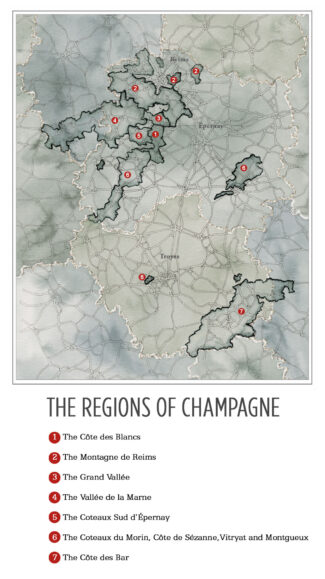
Phrasing it succinctly is Laherte Frères proprietor Aurélien Laherte: “Our wines show more clay influence than those of the Côte des Blancs and they are chalkier than the wines of the Vallée de la Marne.”
In short, these Champagnes are uniquely situated to offer the best of both worlds. As a result, the Coteaux Sud d’Épernay has long fought for recognition as entity unto itself, not necessarily a sub-region of its big brothers on either side.
Champagne Laherte Frères
Terroir Fundamentals: Preserving Its Details
That Champagne is, above all, a style of wine should be obvious, but a common misinterpretation (fueled in part by tradition and in part by marketing) removes it from viniculture and places it on a pedestal of the imagination. Nothing wrong with this, of course, so long as the ground floor remains intact.
Aurélien Laherte, along with his high school friend Raphael Bérèche, would like to see these ideas put into context. A group of Champagne’s more progressive producers, including Agrapart, Marie-Courtin, Vincent Laval and Benoît Lahaye, gathers each spring to taste the ‘vins clairs’—wines meant to become Champagne, but having not yet undergone the bubble-creation process. These are not necessarily ‘still wines’ in that they are not meant to stand on their own merits, but have terroir-transparency profiles to make them suitable for top-shelf sparkling versions.
The Laherte stamp-of-approval was placed on Champagne’s brow many years ago: Founded in 1889 by Jean-Baptiste Laherte, the estate was originally made up of vines grown in and about the village of Chavot. With his wife Cécile, fourth-generation vigneron Michel Laherte expanded the holding, modernized the press and tanks, and may be credited with realizing that the use of herbicides and pesticides prevents full terroir-expression in the wines. The philosophy of hand-working the soils, gently vinifying the juices, and remaining humble and patient as the wines develop became the foundational theme of the estate and endures to this day.
Situated largely in the Côteaux Sud D’Épernay, Laherte vineyards themselves total 26 acres subdivided into 75 separate parcels. Seven of these are farmed biodynamically and certified organic, with the rest farmed either ‘uncertified organic’ or sustainably. Each produces detailed wines that the estate seeks to showcase individually.
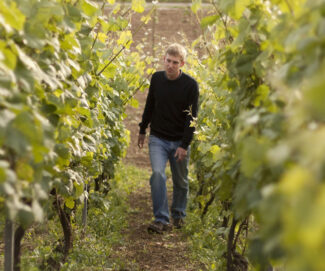
Aurélien Laherte, Champagne Laherte Frères
Aurélien Laherte took over in 2005 and is today considered to be one of the most dynamic vignerons in the appellation. From the multiple individual parcels, the estate produces a series of tiny production, single-vineyard, single-vintage cuvées (around 3,000 bottles each) from some of their most unique and expressive biodynamically-farmed parcels. Many of these wines are fermented and aged in used Burgundy barrels, without malolactic, and are bottled without fining and filtration. They are then finished with little or no dosage so as to not mask the individuality of the underlying terroirs.
Aurélien and his parents are registered as a négociant all the fruit grown by an extended family can be incorporated into his blends. “This is,” says, “the best way to contend with complicated French inheritance laws and keep the estate whole.”
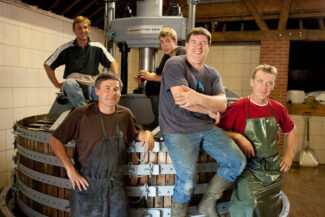
The team, Aurélien upper left
Great lengths are taken to ensure each vine fully expresses itself and its underlying terroir. A team of ten, including aunts, uncles, and cousins, works throughout the year (in accordance with the lunar calendar) to employ techniques such as plant infusions to improve the vine’s natural defense system, and high foliage to encourage photosynthesis and thus, balanced maturity.
Village Chavot: Diversity of Soil
The commune of Chavot-Courcourt consists of Chavot (in the northeastern part of the commune) and Courcourt (in the central part of the commune), but also the small villages Ferme du Jard, Les Fleuries, La Grange au Bois, and Le Pont de Bois. Among the many folds and hills in the area, the upper reaches are clay-dominant while the soils turn chalkier as you descend. Most of the vineyards in Chavot-Courcourt are located in the northern part of the commune, on slopes formed by the stream Le Cubry.
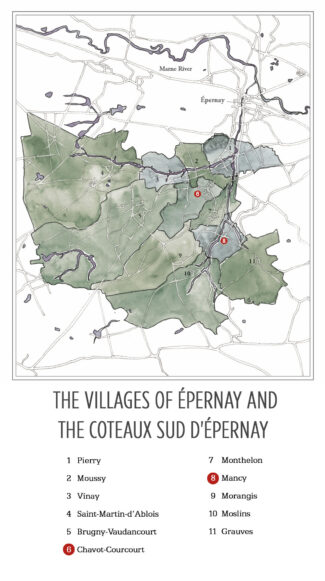
Aurélien Laherte explains why he farms so many individual parcels in a relatively small area: “Below the village especially is a significant difference in soil types. I have identified 27 terroir-types in Chavot-Courcourt alone and farm 45 parcels. There is no sand, but there is virtually everything else—from chalk to clay to limestone. Between them are countless fine-grained distinctions, so I treat them individually and vinify them separately.”
Les Beaudiers is a vineyard in Chavot where Laherte Frères has old vines of Meunier (planted in 1953, 1958, and 1965) that are used for a rosé saignée. Other vineyard sites in Chavot-Courcourt include Les Charmées, Les Chemins d’Epernay, Les Monts Bougies, Les Noelles, La Potote, and Les Rouges Maison, all used by Laherte Frères for their Champagnes Les Vignes d’Autrefois and Les Empreintes.
Although Meunier is the dominant grape variety, Laherte also owns a vineyard called ‘Les Clos’ where he plants all seven legally allowable Champagne grape varieties. From this he concocts the individual-vinification philosophy by picking and pressing all seven varieties together.
Single Variety (Monocépage): Burgundy Comes to Champagne
Bordeaux, and indeed much of Champagne, blends grape varieties to create signature ‘house’ wines. In Burgundy, the thinking is different: Burgundies are primarily monocépages, meaning they are made from a single grape variety, often sourced from a single vineyard. In Bordeaux, the monocépage concept is virtually unknown, but in Champagne, most prominent producers will offer at least one or two in their portfolio, Blanc de Noir or Blanc de Blanc. Frequently they are vintage cuvée produced only in years where a special set of conditions are met and only released in limited quantities.
• Blanc de Blancs
Blanc de Blancs—a term found only in Champagne—used to refer to Champagne produced entirely from white grapes, most commonly Chardonnay. Pinot Blanc and Arbanne can also be used, as well as a number of other varieties permitted in the appellation, but these are much less common.
Chardonnay – ‘Emblematic Cuvée’
In Chardonnay Muscaté this mutation of Chardonnay is a genuine thing; it is grown somewhat extensively in New York state and Ontario under the name Chardonnay Musque and shows an exotic flavor profile that includes tropical fruit notes and cinnamon-tinged lemon sorbet.
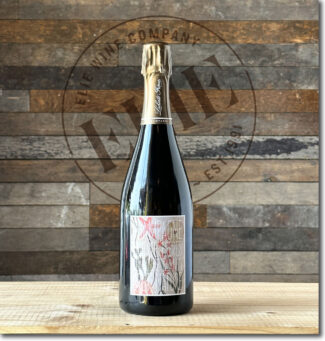 Champagne Laherte Frères, nv Chavot & Épernay ‘Blanc de Blancs’ Brut-Nature ($53)
Champagne Laherte Frères, nv Chavot & Épernay ‘Blanc de Blancs’ Brut-Nature ($53)
From the chalkiest soils on the south slopes of Épernay and the Côte des Blancs, where Chardonnay vines average 35 years, Laherte hand-picks the grapes and ferments the juice in small foudres and barrels, relying on few bâtonnages. It is assembled using 50% reserve wines from previous vintages aged in barrels on lees; hence, the non-vintage label. Malolactic fermentation is partial and disgorgement is done by hand, without dosage. As a ‘non-dosé’, the wine is filled with shivery acidity, showing citrus and apple peel with accents of ginger and finishing with crushed rock minerality. Disgorged February 2022.
*click on photo for more info
Petit Meslier – ‘Vibrant and Expressive’
Petit Meslier is a somewhat rare white-wine grape grown in small quantities in Champagne. It is noted for its heat resistance and ability to maintain acids during long spells of hot weather and when vinified as a monocépage, provides tremendous aromatic intensity and depth.
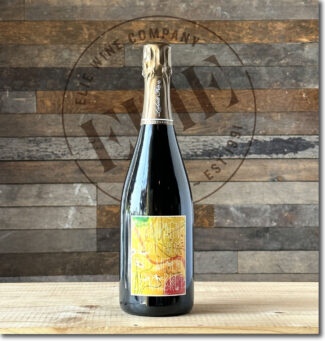 Champagne Laherte Frères ‘Petit Meslier’, nv Chavot Extra-Brut ($120)
Champagne Laherte Frères ‘Petit Meslier’, nv Chavot Extra-Brut ($120)
In creating his iconic, all-inclusive blend ‘Les 7’, Aurélien was particularly struck by the ability of his Petit Meslier to stand on its own. From a vineyard called ‘Cépages Oubliés’, it is blended with 40% reserve wine and aged for six months on its lees ‘fût de chêne’, or in oak barrels; it shows honeyed pear, buttered toast and toasted almonds behind an unsurprisingly racy spine of acidity. Disgorged December 2021.
• Blanc de Noirs
In Champagne, Blanc de Noirs mean that the wine is made from either Pinot Noir or Meunier (or a blend of the two), although it’s relatively common to find 100% Pinot Noir. Despite the ‘Noir’, they may be notably ‘Blanc’ since both Pinot Noir and Meunier are red-skinned, white-fleshed grapes that produce clear juice. Without being given time to macerate on the dark skins, the wine will be white.
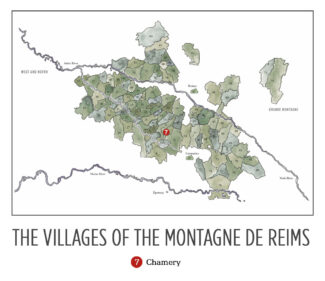
Pinot Noir – ‘Intense and Straight’
Pinot Noir accounts for 38% of the area under vine in Champagne and is the dominant grape in Montagne de Reims and Côte des Bar. It is frequently referred to as ‘Précoce’ due to its tendency to ripen early, leaving behind the acidity so prized by Champagne makers. It thrives in cool, chalky soil—a hallmark of Champagne’s terroir.
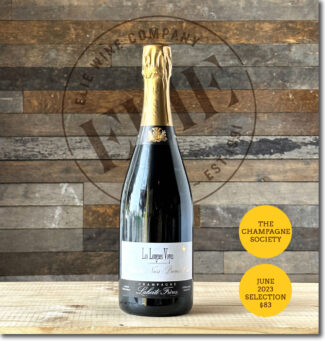 Champagne Laherte Frères ‘Les Longue Voyes’, 2018 Montagne de Reims (Premier Cru Chamery) Blanc de Noirs Extra-Brut ($83)
Champagne Laherte Frères ‘Les Longue Voyes’, 2018 Montagne de Reims (Premier Cru Chamery) Blanc de Noirs Extra-Brut ($83)
Part of Aurélien Laherte’s’ Terroirs’ series, this is his first Blanc de Noirs Champagne made entirely from Pinot Noir. The fruit comes from the village of Chamery on the Petite Montagne de Reims, nearly twenty miles from the estate—hence the name, which means ‘The Long Way’. Barrel aged for 18 months with a 4 g/l dosage and no malolactic, the nose reveals notes of black fruits, and the palate is lively, tense, tasty and tonic with a persistent saline finish. Disgorged December 2021.
*click on photo for more info
Meunier – ‘Celebrating the Variety’
Traditionally used as a blending grape, there are about 26,000 acres of Meunier planted in Champagne, and the variety is rapidly becoming more than an afterthought used for color and balance. In the right soil conditions (calcareous clay with deeper chalk layers) and if allowed to ripen well (leapfrogging the vegetal stage) it can produce a wine that ages remarkably, showing finesse and freshness even after years in the bottle.
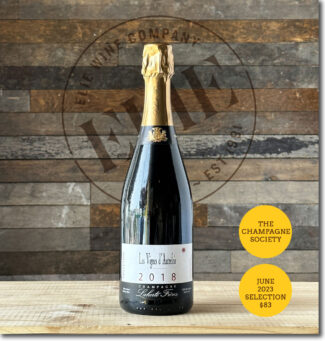 Champagne Laherte Frères ‘Les Vignes d’Autrefois’, 2018 Chavot & Mancy Extra-Brut ($83)
Champagne Laherte Frères ‘Les Vignes d’Autrefois’, 2018 Chavot & Mancy Extra-Brut ($83)
The selected Meunier plots for this wine were planted by the Laherte family between 1947 and 1953 in the villages of Chavot (lieux-dits La Potote and Les Rouges Maisons) and Mancy (lieu-dit Les Hautes Norgeailles). Some of the vines were planted on French rootstock while others are the result of old massal selection. Aurélien uses traditional wooden Coquard presses; fermentation occurs with native yeast in old Burgundy barrels and malolactic fermentation does not take place. The wine ages up to 19 months on the lees and dosage is between two and four grams per liter; it exhibits marvelous aromas of white peach, violets and verbena. Disgorged November 2021.
*click on photo for more info
• Rosé
Credit Madame Clicquot for revolutionizing the (then) relatively small production of pink Champagne. A believer in the idea that a wine should flatter both the eye and the palate, the Grande Dame broke with tradition and re-created the process of making rosé champagne. Before, it was made by adding an elderberry-based mixture to white champagne, but Madame Clicquot had had vines in the Bouzy region of Champagne where she made her own red wine, and she decided to blend this with her still white wines.
This is the most common method of producing rosé Champagne—blending clear white and black grape musts, using between 5 and 15% red wine; it is called a rosé of ‘assembly’. The proportion of red wine can vary, but the white wine must be the majority. Another method of rosé production is the ‘saignée’ method, which involves allowing the must to undergo minimal skin contact, generally for only a couple of hours. This minimal maceration allows the must to develop stronger aromas and flavor profiles while deepening the color. ‘Saignée’ translates literally to ‘bleeding’, which is essentially what the skins are doing for the juice.
Meunier – ‘Strong Identity’
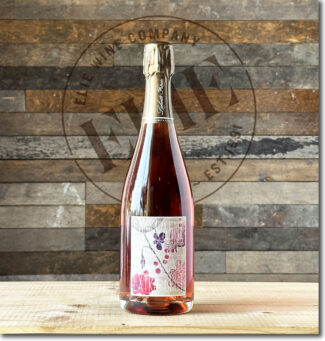 Champagne Laherte Frères ‘Rosé de Meunier’, nv Chavot & Vallée de la Marne (Le Breuil & Boursault) Extra-Brut Rosé d’Assemblage ($54)
Champagne Laherte Frères ‘Rosé de Meunier’, nv Chavot & Vallée de la Marne (Le Breuil & Boursault) Extra-Brut Rosé d’Assemblage ($54)
100% Meunier, the wine is sourced from vineyards in Chavot and Vallée de la Marne (lieux-dits Le Breuil and Boursault) with an average age of 25 years for the Meunier vinified white and more than 40 years for the parcels selected for the red wine. It is a blend of 30% macerated Meunier, 60% white wine from Meunier and 10% still red Meunier. As a result, it uses both methods of Champagne rosé creation, assemblage (blending) and saignée (bleeding). The wine is multi-layered with a ripe core of red fruit and brisk girdling acids. Disgorged March 2022.
*click on photo for more info
Meunier – ‘Varietal Complexity and Nuances’
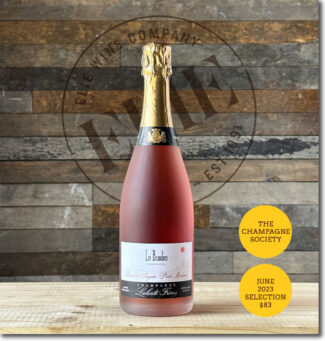 Champagne Laherte Frères ‘Les Beaudiers’, nv Chavot Extra-Brut Rosé de Saignée ($83)
Champagne Laherte Frères ‘Les Beaudiers’, nv Chavot Extra-Brut Rosé de Saignée ($83)
100% Meunier from the ‘Les Beaudiers’ lieu-dit, planted in 1953, 1958 and 1965 on shallow clay and silty soil with chalk beneath. As always, Laherte’s methods include organic maintenance, short pruning for a limited production and regular ploughing. Fermentation takes place in old Burgundy barrels and hand-disgorgement with 0 to 4.5 g/l. The wine shows creamy red cherries, kirsch, buttered toast with strawberry jam and a bright, flinty spine. Disgorged November 2021.
*click on photo for more info
Blending: A Tapestry of Few Threads
Champagne should illustrate the word ‘synergy’ above all, where the sum of the total is greater than the individual parts. The ideal blend should be the aggregation of positive components; every thread should add to the tapestry’s whole. The blend should always drive toward harmony; Chardonnay is often up front, while Pinot Noir supplies the middle and finish. Other allowable varietals should only appear if they contribute to the primary blend.
This is not a universal outcome, of course, and according to Jean-Marc Lallier of Champagne Deutz, “Some winemakers do not blend; they mix.”
When cellar masters do it right, it is a painstaking undertaking; every tank, barrel and vat is tasted countless times to assess which batch would enhance which. This is the true art of Champagne making—the intimate familiarity with each component in order to align them perfectly.
At Laherte, Aurélien does not have a recipe for a single wine; he blends according to the call from the barrel and each blend has a trademark distinction. He prefers very low dosage, insisting that the wine’s minerality must speak first. Regarding the tedious art of blending, he says, “They’re like people; one needs to be strong, one of them weak; one bitter, one elegant.”
‘Highlighting Chavot’s Terroir’
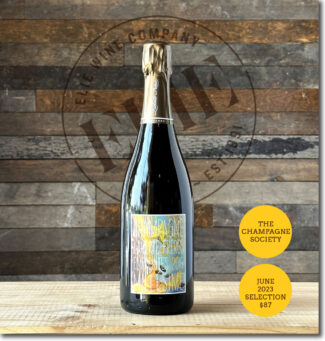 Champagne Laherte Frères ‘Les Empreintes’, 2016 Chavot Extra-Brut ($87)
Champagne Laherte Frères ‘Les Empreintes’, 2016 Chavot Extra-Brut ($87)
From two parcels in the Chavot lieux-dits Les Chemins d’Épernay and Les Rouges Maisons, each (in Aurélien’s words) ‘exemplifying the quintessence of the Chavot terroir.’ The wine is a classic Champagne blend, half Chardonnay, (of which one-third is Chardonnay Muscaté) from Les Chemins d’Epernay where there are clay soils with a little silt stratum in surface and a chalky subsoil—vines planted in 1957. The other half is Pinot Noir from Les Rouges Maison where the soil is fairly deep with a vital presence of clay, flints and schists; these vines were planted in 1983. With a dosage of 3.5 g/l, it is a resonant Champagne with floral top notes and deftly balanced acidity. Disgorged January 2021.
*click on photo for more info
‘Return to Basics’
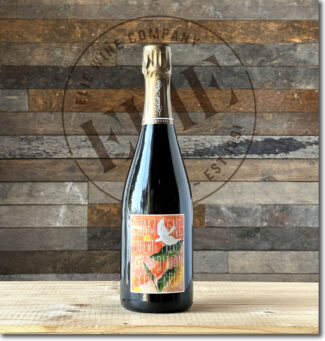 Champagne Laherte Frères ‘Ultradition’, nv Extra-Brut ($48)
Champagne Laherte Frères ‘Ultradition’, nv Extra-Brut ($48)
60% Meunier, 30% Chardonnay, 10% Pinot Noir from vineyard plots in the Côteaux Sud d’Épernay, Vallée de la Marne and Côte des Blancs where vines average around 30 years. The wine ages in barrels for six months and given light filtration before bottling during the spring time; 6-8 gr/l dosage. The wine offers a complex bouquet of dried apple and toasted walnut; the Meunier lends floral tones and an upper-register smokiness. Disgorged November 2021.
*click on photo for more info
‘Tribute to Yesterday’s Wines’
The system of maturation used for Sherry, the famous fortified wine of Jerez, is a cry for consistency from vintage to vintage. The soléra (or perpetual cuvée) system involves removing wine for release from the last of a series of barrels that contains a blend of every vintage since the solera was started. The void in those barrels is then filled with wine from another series of barrels, and so on, until there is room in the youngest series of barrels. The wine from the most recent vintage is added to those barrels.
In Champagne, the method used is slightly different; after each harvest, wine is added to the blend, and every time a producer is ready to release a new batch of non-vintage Champagne, he/she removes what he/she needs. Over time, the cuvée becomes increasingly complex as the fresh wines of the latest vintage taking on the mature qualities of those that came before it. It is a system used by surprisingly few producers in Champagne, but Laherte Frères is one of them.
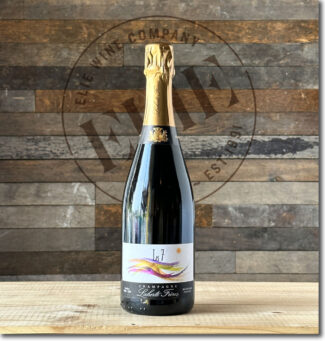 Champagne Laherte Frères ‘Les 7’ Soléra 2005 to 2018, nv Chavot Extra-Brut ($120)
Champagne Laherte Frères ‘Les 7’ Soléra 2005 to 2018, nv Chavot Extra-Brut ($120)
As the name suggests, all seven allowable Champagne grapes are used in this single cuvée; 10% Fromenteau,18% Chardonnay, 18% Meunier, 15% Petit Meslier, 8% Arbanne, 14% Pinot Noir and 17% Pinot Blanc from a vineyard planted by Thierry Laherte in 2003. He picks and presses all seven together and employs his perpetual cuvée: ‘Les 7’ contains wine not only from the current vintage, but draws bits of reserve wine from all harvests dating back to 2005, the year Aurélien took over the domain. All bottles are disgorged by hand with a dosage of 3 g/l. The wine shows lemon zest, crystalline green-apple candy and floral notes in a stony infrastructure. Disgorged January 2021.
*click on photo for more info
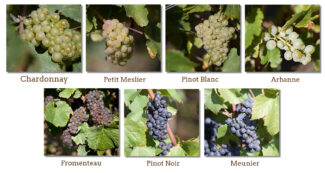
- - -
Posted on 2023.06.01 in France, Saturday Sips Wines, The Champagne Society, Champagne, Wine-Aid Packages
Featured Wines
- Notebook: A’Boudt Town
- Saturday Sips Wines
- Saturday Sips Review Club
- The Champagne Society
- Wine-Aid Packages
Wine Regions
Grape Varieties
Aglianico, Albarino, Albarín Blanco, Albarín Tinto, Albillo, Aleatico, Arbanne, Aubun, Barbarossa, barbera, Beaune, Biancu Gentile, bourboulenc, Cabernet Franc, Cabernet Sauvignon, Caino, Caladoc, Calvi, Carcajolu-Neru, Carignan, Chablis, Chardonnay, Chasselas, Clairette, Corvina, Cot, Counoise, Erbamat, Ferrol, Fiano, Frappato, Friulano, Fromenteau, Fumin, Garnacha, Gewurztraminer, Godello, Graciano, Grenache, Grolleau, Groppello, Juan Garcia, Lambrusco, Loureira, Macabeo, Macabou, Malvasia, Malvasia Nera, Marsanne, Marselan, Marzemino, Melon de Bourgogne, Merlot, Mondeuse, Montanaccia, Montepulciano, Morescola, Morescono, Moscatell, Muscadelle, Muscat, Natural, Nero d'Avola, Parellada, Patrimonio, Petit Meslier, Petit Verdot, Pineau d'Aunis, Pinot Auxerrois, Pinot Blanc, Pinot Gris, Pinot Meunier, Pinot Noir, Poulsard, Prieto Picudo, Rondinella, Rousanne, Roussanne, Sangiovese, Sauvignon Blanc, Savignin, Semillon, Souson, Sparkling, Sumoll, Sylvaner, Syrah, Tannat, Tempranillo, Trebbiano, Trebbiano Valtenesi, Treixadura, Trousseau, Ugni Blanc, vaccarèse, Verdicchio, Vermentino, Viognier, Viura, Xarel-loWines & Events by Date
- April 2024
- March 2024
- February 2024
- January 2024
- December 2023
- November 2023
- October 2023
- September 2023
- August 2023
- July 2023
- June 2023
- May 2023
- April 2023
- March 2023
- February 2023
- January 2023
- December 2022
- November 2022
- October 2022
- September 2022
- August 2022
- July 2022
- June 2022
- May 2022
- April 2022
- March 2022
- February 2022
- January 2022
- December 2021
- November 2021
- October 2021
- September 2021
- August 2021
- July 2021
- June 2021
- May 2021
- April 2021
- March 2021
- February 2021
- January 2021
- December 2020
- November 2020
- October 2020
- September 2020
- August 2020
- July 2020
- June 2020
- May 2020
- April 2020
- March 2020
- February 2020
- January 2020
- December 2019
- November 2019
- October 2019
- September 2019
- August 2019
- July 2019
- June 2019
- May 2019
- April 2019
- March 2019
- February 2019
- January 2019
- December 2018
- November 2018
- October 2018
- September 2018
- August 2018
- July 2018
- June 2018
- May 2018
- April 2018
- March 2018
- February 2018
- January 2018
- December 2017
- November 2017
- October 2017
- September 2017
- August 2017
- July 2017
- June 2017
- May 2017
- April 2017
- March 2017
- February 2017
- January 2017
- December 2016
- November 2016
- October 2016
- September 2016
- August 2016
- July 2016
- June 2016
- May 2016
- April 2016
- March 2016
- February 2016
- January 2016
- December 2015
- November 2015
- October 2015
- September 2015
- August 2015
- July 2015
- June 2015
- May 2015
- April 2015
- March 2015
- February 2015
- January 2015
- December 2014
- November 2014
- October 2014
- September 2014
- August 2014
- July 2014
- June 2014
- April 2014
- March 2014
- February 2014
- January 2014
- December 2013
- November 2013
- October 2013
- September 2013
- August 2013
- July 2013
- June 2013
- May 2013
- April 2013
- March 2013
- February 2013
- January 2013
- December 2012
- November 2012
- October 2012
- February 2004
Search



